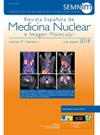Relación entre el estado de HER2 adquirido a partir de los datos patológicos y los parámetros metabólicos obtenidos mediante [18F]FDG PET/TC pretratamiento en adenocarcinomas gástricos
IF 1.6
4区 医学
Q3 RADIOLOGY, NUCLEAR MEDICINE & MEDICAL IMAGING
Revista Espanola De Medicina Nuclear E Imagen Molecular
Pub Date : 2025-07-01
DOI:10.1016/j.remn.2024.500080
引用次数: 0
Abstract
Objective
Overexpression of Human Epidermal Growth Factor Receptor 2 (HER2) is thought to be more aggressive in gastric cancer. This study aimed to evaluate the predictability of HER2 status and other prognostic pathologic parameters using [18F]FDG PET/CT and to investigate its impact on survival.
Methods
Pretreatment metabolic parameters measured by [18F]FDG PET/CT as a prognostic factor were retrospectively evaluated in 117 HER2-analysed patients. The relationship between pathological data, tumor metabolic characteristics, and distant metastases was examined, and the effect on survival was investigated.
Results
Among the 117 patients, 17.1% were HER2-positive (HER2+), and 82.9% were HER2-negative (HER2−). There was no significant association between PET/CT parameters in the HER2+ and HER2− patient groups. HER2+ patients had higher 1- and 3-year survival expectations than HER2− patients (80-37.9%; 47.5-20%; respectively). There was no statistically significant difference in overall survival. In Cox-regression analysis, while the presence of vascular invasion, local invasion, and distant metastasis were poor prognostic factors, HER2 was not a prognostic factor. Vascular invasion and local invasion (T3/T4) were also associated with higher SUVmax values. Patients with distant metastases had significantly higher SUVmax, SUVmean, and TLG.
Conclusion
This study showed no association between HER2 expression and [18F]FDG PET/CT metabolic parameters. However, regardless of HER2 status, the results indicated distant metastasis, local invasion, and vascular invasion could be associated with primary tumor metabolism. PET/CT parameters predict tumor aggressiveness and disease prognosis better than HER2 status.
通过[18F]FDG PET/TC预处理胃腺癌的病理数据获得的HER2状态与代谢参数之间的关系
目的人表皮生长因子受体2 (HER2)过表达被认为在胃癌中更具侵袭性。本研究旨在利用[18F]FDG PET/CT评估HER2状态和其他预后病理参数的可预测性,并探讨其对生存的影响。方法回顾性评估117例her2分析患者的治疗前代谢参数[18F]FDG PET/CT作为预后因素。检查病理资料、肿瘤代谢特征与远处转移的关系,并探讨对生存的影响。结果117例患者中,HER2阳性(HER2+)占17.1%,HER2阴性(HER2−)占82.9%。HER2+和HER2 -患者组PET/CT参数之间无显著相关性。HER2+患者的1年和3年生存率预期高于HER2 -患者(80-37.9%;47.5 - -20%;分别)。两组总生存率无统计学差异。cox -回归分析中,血管浸润、局部浸润和远处转移是不良预后因素,HER2不是预后因素。血管侵犯和局部侵犯(T3/T4)也与较高的SUVmax值相关。远处转移患者的SUVmax、SUVmean和TLG显著升高。结论本研究显示HER2表达与[18F]FDG PET/CT代谢参数无相关性。然而,无论HER2状态如何,结果表明远处转移、局部侵袭和血管侵袭可能与原发性肿瘤代谢有关。PET/CT参数预测肿瘤侵袭性和疾病预后优于HER2状态。
本文章由计算机程序翻译,如有差异,请以英文原文为准。
求助全文
约1分钟内获得全文
求助全文
来源期刊

Revista Espanola De Medicina Nuclear E Imagen Molecular
RADIOLOGY, NUCLEAR MEDICINE & MEDICAL IMAGING-
CiteScore
1.10
自引率
16.70%
发文量
85
审稿时长
24 days
期刊介绍:
The Revista Española de Medicina Nuclear e Imagen Molecular (Spanish Journal of Nuclear Medicine and Molecular Imaging), was founded in 1982, and is the official journal of the Spanish Society of Nuclear Medicine and Molecular Imaging, which has more than 700 members.
The Journal, which publishes 6 regular issues per year, has the promotion of research and continuing education in all fields of Nuclear Medicine as its main aim. For this, its principal sections are Originals, Clinical Notes, Images of Interest, and Special Collaboration articles.
 求助内容:
求助内容: 应助结果提醒方式:
应助结果提醒方式:


